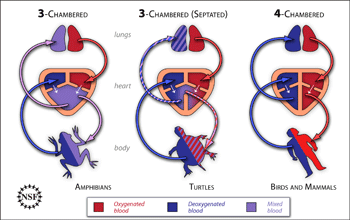Multimedia Gallery
Evolution of the Heart (Image 2)
The three-chambered frog heart mixes oxygenated and deoxygenated blood in the ventricle. Therefore, the body never receives fully oxygen-rich blood. In turtles, where a septum begins to form and separate the ventricles, the body receives slightly richer blood in oxygen. It is only in the warm-blooded model, in birds and mammals, that the two circulatory systems become fully separate sending low-pressure pumping to the lungs, and a high-pressure flow of blood to the rest of the body. In this model, the animal's muscles receive fully oxygenated blood. Recent research has found the first genetic link in the evolution of the heart from three-chambered to four-chambered, illuminating part of the puzzle of how birds and mammals became warm-blooded.
This image accompanied NSF press release, "Secrets of the Four Chambers Revealed by Reptile Hearts." [See related image Here.]
Credit: Zina Deretsky, National Science Foundation
Images and other media in the National Science Foundation Multimedia Gallery are available for use in print and electronic material by NSF employees, members of the media, university staff, teachers and the general public. All media in the gallery are intended for personal, educational and nonprofit/non-commercial use only.
Images credited to the National Science Foundation, a federal agency, are in the public domain. The images were created by employees of the United States Government as part of their official duties or prepared by contractors as "works for hire" for NSF. You may freely use NSF-credited images and, at your discretion, credit NSF with a "Courtesy: National Science Foundation" notation.
Additional information about general usage can be found in Conditions.
Also Available:
Download the high-resolution JPG version of the image. (481 KB)
Use your mouse to right-click (Mac users may need to Ctrl-click) the link above and choose the option that will save the file or target to your computer.

